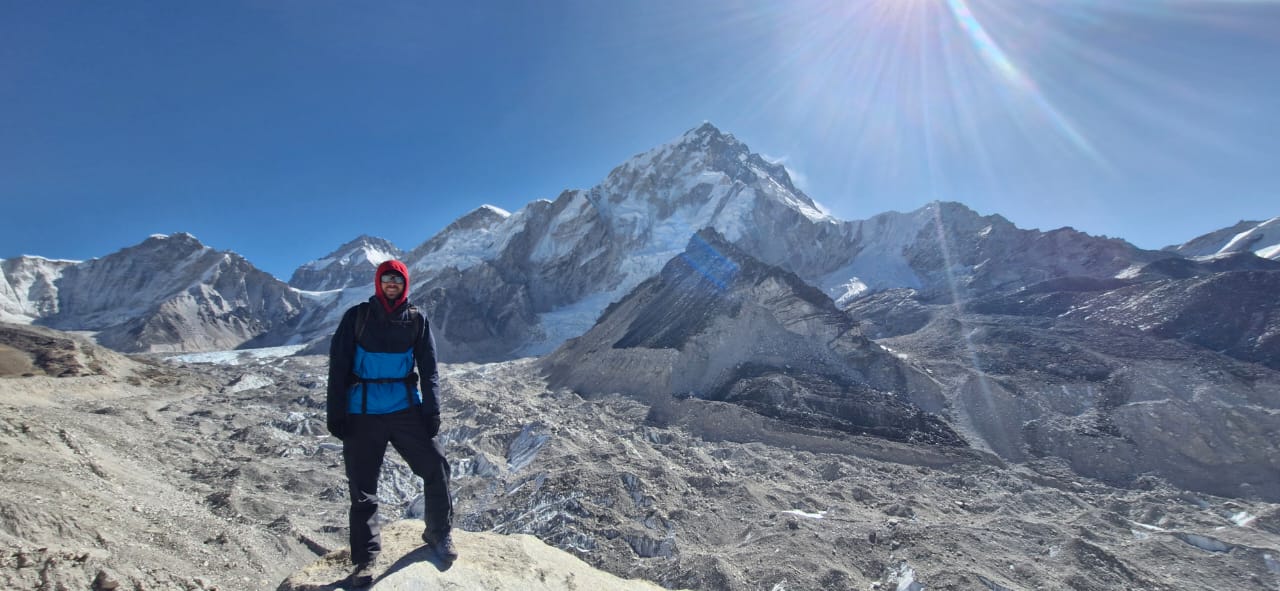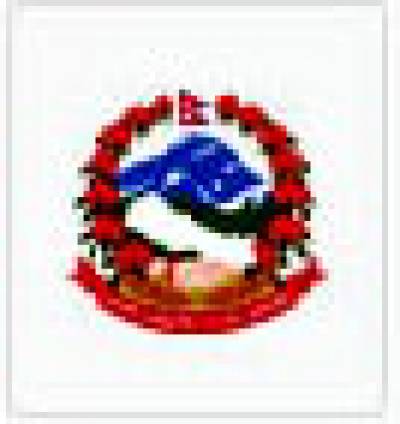SHORTERST EVEREST THREE HIGH PASS TREK 11 DAYS
The Shortest Everest Three High Pass Trek is a tough and adventurous trip in the Everest area for highly skilled trekkers. The trek for this will take about 11 days and involve rugged trails, steep climbing, and crossing three significant-high passes i.e. Kongmala Pass, Renjo La Pass, and the Cho La Pass. Due to the physical demands of the trek and the high altitudes , this one is not for beginners or those with limited trekking experience.
The adventure starts with an early morning flight from Kathmandu to Lukla, possibly the most famous airport in the world. After a short flight to Lukla, the trek starts with up to Jorsalle, a small settlement where climbers stop to rest before making their way up toward the famed Tengboche Monastery. The scenery along the way is breathtaking, revealing glimpses of Everest, Ama Dablam, and other gargantuan peaks.
From Tengboche, you’ll head to Chhukung, where you’ll acclimatize and prepare for crossing the Kongmala Pass, one of the highest altitude points on the trek (over 5,500 meters, or 18,000 feet). Attain views of Everest and other mountain giants at the Kongmala Pass. From there, you’ll travel to Everest Base Camp, a dream destination that puts you alongside the rising Everest massif. You’ll later visit Kala Patthar, where the sunrise views of Everest and surrounding peaks become one of the trek’s highlights.
From there, you trek through Dzongla and cross the Renjo La Pass, a challenging high point that provides stunning views of the surrounding mountains, including Makalu and Cho Oyu. Once over Renjo La, the trail leads to breathtaking Gokyo Lakes, with crystalline waters and soaring mountain summits. The following day brings a trek to Thame, a lovely Sherpa town, then Phakding and return to Lukla.
The flight from Lukla returns you to Kathmandu to end this remarkable, demanding, and rewarding journey through some of the tallest and most inaccessible parts of the Everest Himalayas.
IMPORTANCE NOTICE: This trek is not for beginner trekkers. It is only suitable for very highly experienced trekkers who have completed several treks at altitudes above 5000 meters. Additionally, please note that from March to May and September to December, the Lukla flights will operate from Ramechhap. You will need to drive 5-6 hours from Kathmandu to Ramechhap to catch the flight.
ITINERARY
Day 1 : Fly from Kathmandu to Lukla & Trek to Jorsalle (2,740m) Duration: 7-8 hours.
Your adventure begins with an early morning flight from Kathmandu to Lukla, a thrilling journey that offers sweeping views of the Himalayas. Upon landing in Lukla, you'll begin your trek toward Jorsalle, a picturesque village nestled in the Everest region. The route follows the Dudh Koshi River, passing through lush forests and quaint villages. You'll cross several suspension bridges, taking in the natural beauty of the area. After a long day of hiking, you'll reach Jorsalle, where you’ll spend the night to rest and acclimatize.
Day 2 : Trek from Jorsalle to Tengboche (3,867m) Duration: 7-9 hours.
On Day 2, you'll trek toward Tengboche, a scenic village famous for the Tengboche Monastery. The day’s hike involves a steady climb with stunning views of Everest, Lhotse, and Ama Dablam. You’ll cross several suspension bridges along the way, with the final ascent leading to Tengboche, situated at an elevation of 3,867 meters (12,687 feet). The monastery here is a serene spot to visit and a key highlight of the trek. Afterward, you'll rest and acclimatize for the days ahead.
Day 3 : Trek from Tengboche to Chhukung (4,730m) Duration: 7-8 hours.
Day 3 sees you trekking to Chhukung, a beautiful village located at 4,730 meters (15,518 feet). The trail continues along the Dudh Koshi River, passing through lush forests and small settlements before the climb towards Chhukung. The village lies at the base of the stunning Ama Dablam, and offers breathtaking views of surrounding peaks. The high altitude requires careful acclimatization, so the overnight stop in Chhukung is essential to help your body adjust to the thinning air.
Day 4 : Cross Kongma La Pass (5,535m) & Trek to Lobuche (4,910m) Duration: 7-9 hours.
On Day 4, the trek gets more challenging as you cross Kongma La Pass, located at 5,535 meters (18,159 feet). This is a demanding day, as you'll need to trek through a rugged terrain of rocky paths and high-altitude trails. The views from the pass are simply incredible, offering a panoramic vista of the Khumbu region’s majestic peaks, including Mount Everest. After crossing the pass, you’ll continue down to Lobuche, where you’ll rest for the night at an elevation of 4,910 meters (16,109 feet).
Day 5 : Trek to Gorakshep & Visit Everest Base Camp (5,364m) & Return to Gorakshep Duration: 7-8 hours.
This is one of the most exciting days of the trek! From Lobuche, you’ll trek to Gorakshep, located at 5,180 meters (16,994 feet). Once in Gorakshep, you’ll drop off your gear and head towards Everest Base Camp. The walk is a gradual ascent, but the sight of Base Camp, situated at 5,364 meters (17,598 feet), is worth every step. After spending time at Base Camp, you’ll return to Gorakshep for the night.
Day 6 : Hike Up to Kala Patthar (5,555m) & Trek to Dzongla (4,830m) Duration: 6-7 hours.
On Day 6, you’ll wake up early to hike to Kala Patthar, one of the best vantage points for views of Mount Everest. From this point, you’ll be treated to spectacular 360-degree views of Everest, Lhotse, Nuptse, and other surrounding peaks. After taking in the breathtaking scenery, you’ll descend back to Gorakshep and continue your journey to Dzongla, a small settlement at 4,830 meters (15,849 feet), where you’ll spend the night.
Day 7 : Cross Cho La Pass (5,420m) & Trek to Gokyo (4,790m) Duration: 9-10 hours.
Day 7 brings the challenge of crossing Cho La Pass, located at 5,420 meters (17,782 feet). The trek to the pass is a tough, steep climb, but the views from the top are magnificent. After crossing the pass, you’ll descend into the beautiful Gokyo Valley, where you’ll arrive at Gokyo, a serene village at 4,790 meters (15,715 feet), known for its stunning Gokyo Lakes. The clear blue lakes set against the backdrop of the towering peaks make this a peaceful stop on the trek.
Day 8 : Cross Renjo La Pass (5,360m) & Trek Down to Thame (3,820m) Duration: 7-9 hours.
On Day 8, you’ll cross Renjo La Pass, located at 5,360 meters (17,585 feet), and then descend into the peaceful Thame Village. The Renjo La Pass offers incredible views of Mount Everest, Makalu, and other peaks. After descending through the valley, you’ll reach Thame, a charming village known for its Buddhist culture and stunning mountain views.
Day 9 : Trek from Thame to Phakding (2,640m) Duration: 6-7 hours.
Day 9 brings a gradual descent through the valley, passing through various Sherpa villages, lush forests, and clear rivers. You’ll trek from Thame to Phakding, located at 2,640 meters (8,661 feet), where you’ll rest for the night. This marks the beginning of your return journey to Lukla.
Day 10 : Trek from Phakding to Lukla (2,860m) Duration: 4-5 hours.
On the final leg of your trek, you’ll make your way back to Lukla from Phakding. The trail is easier than the previous days, with gentle downhill slopes leading to Lukla. Once in Lukla, you’ll celebrate the completion of your trek, relax, and prepare for the return flight to Kathmandu.
Day 11 : Fly Back to Kathmandu Duration: 35 minutes.
On Day 11, you’ll board a flight from Lukla back to Kathmandu. This short, scenic flight over the Himalayas offers one last glimpse of the magnificent mountains before you return to the bustling capital, marking the end of your unforgettable Everest Three High Pass Trek.
SERVICES
What’s Included in Your Package:
- Domestic Airport pick-up and private car/jeep transport.
- Three meals a day (breakfast, lunch, and dinner) during the trek.
- Fresh fruit is served every evening after dinner.
- Accommodation in trekking lodges (Tea Houses) throughout the trek.
- All necessary paperwork, including the Sagarmatha National Park Entry Permit and Khumbu Pasang Lhamu Rural Municipality fees.
- Round-trip Kathmandu-Lukla-Kathmandu flights, along with private airport transfers and domestic airport taxes.
- A highly experienced, friendly, knowledgeable, English-speaking, government-licensed guide, with all his salary, meals, accommodation, transport, and insurance covered.
- Strong and helpful Sherpa porters (one porter for every two trekkers), equipped with proper safety and walking gear, including their salary, meals, accommodation, and insurance.
- Comprehensive medical supplies, including a first aid kit.
- Emergency helicopter service arrangements (covered by your travel insurance company).
- Use of a sleeping bag, down jacket, duffel bag, and walking poles (if you don’t have your own; to be returned after the trip).
- Sherpa Expedition and Trekking T-shirt.
- Government taxes and official expenses.
- Oxygen meter to monitor your pulse, oxygen saturation, and heart rate twice daily, helping to detect any symptoms of Altitude Mountain Sickness (AMS) and ensuring your well-being during the trek.
- Assistant guide for groups of 8 or more people.
What’s Not Included in Your Package:
- Meals in Kathmandu (lunch and dinner).
- Hotel accommodation in Kathmandu.
- Nepal entry visa fee (easily obtained on arrival at Tribhuvan International Airport in Kathmandu). Visa fees are as follows: $30 USD for a 15-day visa, $50 USD for a 30-day visa, and $125 USD for a 90-day visa.
- Personal travel and medical insurance.
- International airfare.
- Personal expenses (e.g., souvenirs, additional services).
- All alcoholic and non-alcoholic beverages, including soup, tea, coffee, hot chocolate, cocoa, mineral water, extra food, and cold or hot drinks during the trek (purchased along the way or in the tea houses).
- Desserts and sweet items such as chocolate, cake, pie, and pudding.
- Hot showers and battery charging services at the tea houses.
- Tips for the guide, porter, and driver (tipping is customary).
- Excess baggage over 10 kg for the Lukla flight.
Note: If you need to return early from the trek due to illness or any unforeseen circumstances, the costs for the flight, hotel, meals, mountain rooms, etc., are non-refundable. You will be responsible for any additional expenses in Kathmandu, including hotel and food costs.
EQUIPMENTS
The following information will give you some idea about what you need to bring for the trek. It is important you do not forget the essential items, as this will determine your comfort and safety on the trek. Equally important is that you do not burden yourself with unnecessary equipment on the trek.
General
- All season sleeping bag and down Jacket (we can provide if you need it, but has to be returned after the trek)
- Duffle bag ( Sherpa Expedition & Trekking provide duffle bag during the trek but has to be returned after the trek)
- A wind and waterproof thin layered jacket (a must-have for morning and evenings above 3,000m)
- Daypack
Upper Body- Head / Ears / Eyewear
- A pair of half gloves
- A warmer hat that covers the ears
- Sunglasses
- Neckwarmer
- Sunscreen (35 to 60 SPF)
- Headlamp and an extra set of batteries
Hands
- A pair of half gloves for walking poles(if you prefer)
- Warmer shell gloves and liner
Upper Body
- long sleeve t-shirts
- Thermal tops
- wool jacket or pullover
- Sports bras for women and girls
- Water and windproof shell jacket
Lower Body
- Thermal underwear (especially trousers)
- Crampons
- windproof and waterproof trousers
- warmer trousers
- Comfortable trekking pants
- Extra casual sport pants
Footwear
- A pair of good waterproof trekking boots
- Pair of sandals
- 4-5 pairs of woolen socks
- Sock liners
- Light shoes and sneakers
- First Aid Kits and Medicines
- Assorted adhesive bandages (fabric preferred)
- Blister treatment cream or similar
- Insect / anti-itch ointment
- Ibuprofen or other pain-relief medication
- Diamox (125mg to 250mg tablets for altitude sickness)
- Warps, splints, and wound coverings butterfly bandage
- Water purifying pills
(Note our company guide will carry the medicines and first aid kits during the trek. However, we recommend you bring your personal first-aid kit as well)
Miscellaneous - but must be useful on the trek
- 4 passport-size photos with original passport
- Water bottle & filter
- Flight details (please make a copy and leave one pic at our office in KTM because in case you want to change your flight date)
- Bathroom kit (conform, should be included toilet paper, plastic bags, hand wipes, towel, and soap, etc.)
Extra things
- Comfortable trekking poles
- Quality energy dry foods (up to you)
- Power bank and music players
- Camera (memory card, chargers, and extra batteries)
GOOD TO KNOW
🚶♂️ Hard and Tough Hike
Short Everest Three High Pass Trek is one of the most challenging and difficult physical trek for experienced trekkers. This trek takes in three high passes – Kongmala, Renjo La, and Cho La – all of them over 5,000 meters, and it’s a serious test for those unfamiliar with high-altitude trekking. You should be physically fit, and have great stamina, and mental toughness to tolerate steep climbs, long hours of trekking, and extreme altitudes.
✈️ Flight to Lukla
The journey starts with a thrilling flight from Kathmandu to Lukla. That 30-minute flight provides spectacular views of the Himalayas and lands at one of the world’s most famous — and difficult — airports. Lukla is your entry to the Everest region and the starting point of this arduous trekking journey. Be ready for this exciting adventure as weather can affect your flight!
🏔️ High Altitude & Acclimatization
With the speed of elevation gained during this trek, proper acclimatization is extremely important. You will be doing trekking at a height above 5000 meters with the highest point being Kongmala Pass. Altitude sickness is an actual threat, so listen to your body and force yourself to take breaks when you're feeling out of breath. The trek’s schedule includes specific acclimatization days to help you acclimatize to the high altitudes, but be intelligent about your physical health.
🧳 What to Pack
What to pack for this challenging trek You’ll have to pack for extreme weather, so make sure to take warm layers, waterproof gear, a comfortable pair of walking boots, and a quality sleeping bag. This trek is on rough terrain, so it’s advised that you bring a pair of trekking poles to aid you. And because you’ll mostly be hiking in high-elevation regions, don’t forget sunscreen, sunglasses, and lip balm to protect from sun exposure.
🌄 Stunning Views
The Shortest Everest Three High Pass Trek provides some of the most amazing panoramic sights of the Everest region. You’ll get stunning vistas of Mount Everest, Ama Dablam, Cho Oyu, and Makalu, particularly from vantage points like Kala Patthar and the Gokyo Lakes. The views on the hike are stunning and make the challenge worth it. Have a camera at the ready to document these moments, you'll never regret it.
🛑 Not for Beginners
This trek is for those trekkers who are very experienced in high-altitude hiking. This trek is not suitable for the novice or trekkers who have little experience. The difficulty of the trek, high altitudes and unpredictable weather make it only suitable for those who have done multi-day treks in similar conditions before.
⚖️ Must Be Physically Fit
This trek is physically challenging and preparation is crucial. Make sure that you have very good endurance and stamina for long days of hiking, plus strength for the steep ascents and the effects of the high altitude. Lifting weights such as backpacks and doing cardio will serve to simulate what the trek will feel like.
🌞 Best Time to Trek
The best season to do the Shortest Everest Three High Pass Trek is in the spring (March to May) and the autumn (September to November). These months provide the clearest weather, the best views, and the most comfortable temperatures for trekking. However, bear in mind that weather conditions in high altitudes can change very quickly, so be ready for all circumstances.
🧑🤝🧑 Guides and Porters
For safety and comfort, it is strongly advised to have an experienced guide and porter trek with you. Host your trek in the hands of a guide who will guide, and educate you about the local culture, landscape, and flora as well as ensure your safety on the trek. A porter will carry your heavier load, so you can concentrate on the rugged terrain. Sherpa guides, especially, are worth their weight in gold given their familiarity with the Everest region.
9️⃣ Key Health Concerns
Trekking in high-altitude environments can jeopardize health if you are not aware of potential risks. For the altitude sickness, you will need to carry your medicines like Diamox, and other medicines if any. Also, keep yourself hydrated. Be oriented to any signs of altitude sickness such as dizziness, headaches, or nausea, and report to your guide if you experience any. Remember that altitude sickness does not discriminate: it can affect anyone, regardless of how fit you are.
It is, without doubt, one of the world's most amazing adventures, but understanding the scope of the challenges you will face is important for having a safe, successful, and rewarding trek.
MAP
PHOTOS/Videos
Departures
Select a departure month
Fill out the form below and a Travel Expert will reach out to create your perfect tour.
FAQS
Is the Shortest Everest Three High Pass Trek suitable for beginners?
No, this trek is not suitable for beginners. It is a very challenging trek that requires prior high-altitude trekking experience. The trek involves steep climbs, crossing three high passes, and long hiking days, which makes it ideal only for experienced trekkers.
How physically demanding is the Shortest Everest Three High Pass Trek?
This trek is extremely physically demanding, with long days of trekking (7-9 hours) at high altitudes. You will be trekking over challenging terrain and crossing passes higher than 5,000 meters, which requires excellent physical fitness, endurance, and strength.
What is the highest altitude of the trek?
The highest point of the trek is the Kongmala Pass, which sits at an altitude of about 5,500 meters (18,000 feet). Other high passes, such as Renjo La and Cho La, are also above 5,000 meters.
What is the best time to do the Shortest Everest Three High Pass Trek?
The best time to do this trek is during the spring (March to May) or autumn (September to November). During these months, the weather is generally clear, with mild temperatures and minimal rainfall, providing the best conditions for trekking.
Do I need a guide and porter for the trek?
The best time to do this trek is during the spring (March to May) or autumn (September to November). During these months, the weather is generally clear, with mild temperatures and minimal rainfall, providing the best conditions for trekking.
Do I need a guide and porter for the trek?
Yes, it is highly recommended to trek with an experienced guide and porter. The guide will help with navigation, ensure your safety, and provide valuable information about the region, while the porter will carry your heavier load, allowing you to focus on the trek.
How long is the Shortest Everest Three High Pass Trek?
The trek takes approximately 11 days to complete, covering challenging terrain and high altitudes. The duration includes acclimatization days and time to rest in key locations along the way.
Is altitude sickness a concern on this trek?
Yes, altitude sickness is a significant concern on this trek due to the rapid ascent and high altitudes. It is crucial to stay hydrated, take rest days for acclimatization, and listen to your body. Symptoms of altitude sickness should be taken seriously, and any signs should be reported to your guide immediately.
What kind of accommodation can I expect during the trek?
Accommodation during the trek will be in teahouses or basic lodges. These are simple, local guesthouses where you’ll have a bed and basic amenities. Meals are provided, but the accommodations are modest compared to luxury standards.
How do I prepare for this trek?
To prepare, you should focus on building cardiovascular fitness, stamina, and strength. Training with a loaded backpack, performing long walks, and doing altitude-specific exercises will help prepare you for the tough terrain. Additionally, acclimatization and staying well-hydrated are crucial for this high-altitude trek.
Will I need to bring my own gear?
Yes, you will need to bring your own trekking gear, including clothing for cold weather, proper trekking boots, a sleeping bag, and other personal items. Make sure to pack light but efficiently, as you'll need to carry your gear during the trek. If necessary, you can rent or purchase additional gear in Kathmandu before starting the trek.
Latest Traveller’s Reviews
Travel experiences of our clients who recently returned from their trips.
100%
Based On 5506 Reviews
Kirana Ho
Singapore
October 28, 2025
Amazing Experience!
I am so glad that I chose Sherpa Expedition & Trekking to go on this adventure! The whole process starting from the inquiry to the end of the trek was extremely smooth and easy. I had all my questions very promptly answered and Sherpa Expedition also provided the necessary equipment (e.g. walking poles & sleeping bag) which made it very convenient. And of course for the main trek itself! I'm so glad to have Tashi Sherpa and Nima to guide me for this trek. They certainly made the trek more fun and enjoyable even when my body battery was almost depleted and my legs were screaming to stop. Tashi Sherpa made sure everything was well taken care of along the way both in terms of my wellbeing and also the logistics involved. I'm definitely hoping that I would have a chance to go for another expedition with them again :) Thank you for this amazing experience!
Emily Zhao
Singapore
May 28, 2025
Professional Trek, Heartfelt Memories – Led by Tshering
I signed up for the Annapurna Base Camp trek with Sherpa Expedition based on a friend’s recommendation, and now I can confidently say it was the best travel decision I’ve ever made. Our guide, Tshering, was truly special. Calm, experienced, and incredibly warm-hearted, he guided us through every step with confidence and care. What I admired most was how he made sure everyone in the group felt supported. Whether it was helping with altitude or simply offering a kind word during steep climbs, he was always there. The trek itself was stunning—every day revealed a new landscape and view. We trekked through rhododendron forests, past rivers and waterfalls, and finally reached the snow-filled amphitheater of Annapurna Base Camp. Sherpa Expedition managed all logistics perfectly—from flights to accommodation to delicious meals at the tea houses. Tshering taught us about the culture, pointed out peaks, and even made us laugh during the tough sections. The views from base camp were beyond anything I’ve ever seen—pure magic. I left Nepal with new friendships and a heart full of gratitude. Thank you, Tshering, and thank you, Sherpa Expedition, for an unforgettable experience.
Laura Petrovic
Canada
May 13, 2025
Absolutely Magical Trek with Guide Dendi
Trekking to Annapurna Base Camp was one of the most magical experiences of my life. Sherpa Expedition made the entire journey smooth and stress-free, and a huge part of that was thanks to our guide, Dendi. His professionalism, combined with his kindness, made him the perfect companion for this adventure. Dendi was extremely knowledgeable and knew the region inside out—he explained the culture, the peaks, and ensured we were adjusting well to the altitude. Every day was an adventure—crossing rivers, walking through thick forest trails, and climbing toward snow-covered landscapes. Sherpa Expedition’s planning was excellent. The flight from Kathmandu to Pokhara was on time, the porters were friendly and hardworking, and the tea houses we stayed in were comfortable and offered surprisingly good food. Dendi checked our health daily, helped with gear issues, and created a supportive group atmosphere. When we finally reached base camp, the sheer beauty brought tears to my eyes. It felt like standing in the heart of nature. This was not just a trek, but an emotional and beautiful journey. I’m thankful to Dendi and the Sherpa Expedition team. I would absolutely recommend this company for anyone looking to experience the Himalayas.
People Considering This Package Right Now Check availability






















